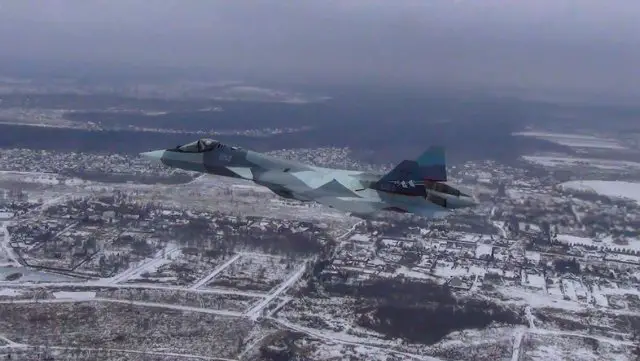Breaking news
Russia' Su-57 fighter jet makes maiden flight with new engine.
| 2017
| a | |||
|
|
|||
|
World Aviation Defense & Security News - Russia
|
|||
|
|
|||
|
Russia' Su-57 fighter jet makes maiden flight with new engine
|
|||
|
Russia’s fifth-generation Su-57/T-50 PAK FA (Prospective Airborne Complex of Frontline Aviation) fighter jet has performed its first flight with a second-phase engine at the Gromov Flight Research Institute in the Moscow Region, the press office of Russia’s United Aircraft Corporation (UAC) said.
|
|||
|
|
|||
 The RuSAF Su-57 flying with second stage engine The RuSAF Su-57 flying with second stage engine(Credit: UAC) |
|||
|
|
|||
|
"The successful flight of the plane with a new engine will give an additional impetus to the fifth-generation fighter jet development program. This proves the high potential of the Russian aircraft industry able to develop cutting-edge smart systems, in particular, unique airframes, innovative digital components and advanced engines," Russian Industry and Trade Minister Denis Manturov said.
The 17-minute flight was performed by Sergei Bogdan who is a chief test pilot of the Sukhoi Company that is a UAC subsidiary. The flight was smooth and was carried out in accordance with the flight task. The first ground start of the second-phase demonstrator engine was carried out at the Machine-Building Plant in Lytkarino in the Moscow Region in November 2016. The engine is being developed by the Lyulka Design Bureau under the supervision of General Designer and Director Yevgeny Marchukov. According to CEO of Russia’s United Engine-Manufacturing Corporation (UEC) Alexander Artyukhov, new design solutions that have no equal in Russia’s engine-manufacturing industry were used during the production of the demonstrator engine. In addition to the demonstrator engine, gas generators of the new engine were also produced. The second-phase jet engine intended for the PAK FA aircraft will feature a FADEC (Full Authority Digital Engine Control) system. The second-phase engine is expected to be 17-18% more effective than the first-phase engine (Unit No. 117). The characteristics of the engine have been improved primarily by the dramatic increase of the working cycle parameters and units performance, as well as by the use of cutting-edge technologies and materials. The engine features an increased thrust and drastically-reduced specific fuel consumption in virtually all working modes, in other words, not only in the maximum distance modes but also in the acceleration and afterburner regimes. This means the reduction of the life cycle cost. The specific weight was planned to be reduced considerably be means of using cutting-edge technologies and materials. The T-50 fighter jet performed its first flight in January 2010. About 10 aircraft of the type are currently taking part in the tests. In accordance with the program, the fighter jet has started to perform trial flights to test its air-launched weapons and is proving its inherent characteristics. Russian Aerospace Force test pilots are testing the plane’s capabilities at the Chkalov State Flight Test Center (GLITs) in Akhtubinsk in south Russia. The testing of a multifunction integrated active electronically scanned array (AESA) radar system on the fifth-generation fighter jet is on schedule. In 2017, the fifth-generation T-50 fighter jet was designated as Sukhoi Su-57. |
|||
|
|
|||
|
© Copyright 2017 TASS. All rights reserved. This material may not be published, broadcast, rewritten or redistributed.
|
|||
,


























